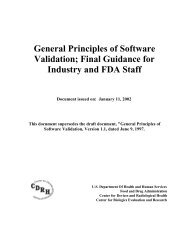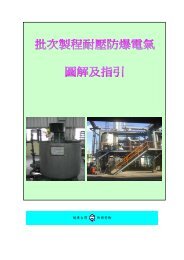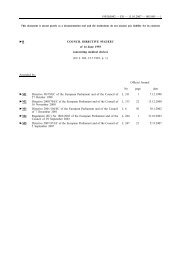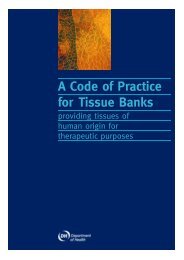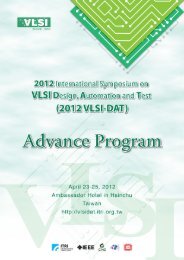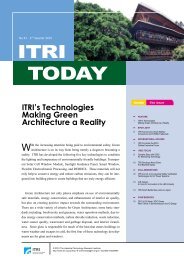Design Control Guidance - Food and Drug Administration
Design Control Guidance - Food and Drug Administration
Design Control Guidance - Food and Drug Administration
Create successful ePaper yourself
Turn your PDF publications into a flip-book with our unique Google optimized e-Paper software.
manufacturers are encouraged to use the terminology of the quality system requirements intheir internal procedures.To illustrate the concepts, consider a building design analogy. In a typical scenario, thesenior architect establishes the design input requirements <strong>and</strong> sketches the generalappearance <strong>and</strong> construction of the building, but associates or contractors typicallyelaborate the details of the various mechanical systems. Verification is the process ofchecking at each stage whether the output conforms to requirements for that stage. Forexample: does the air conditioning system deliver the specified cooling capacity to eachroom? Is the roof rated to withst<strong>and</strong> so many newtons per square meter of wind loading?Is a fire alarm located within 50 meters of each location in the building?At the same time, the architect has to keep in mind the broader question of whether theresults are consistent with the ultimate user requirements. Does the air conditioningsystem keep the occupants comfortable throughout the building? Will the roof withst<strong>and</strong>weather extremes expected at the building site? Can the fire alarm be heard throughout thebuilding? Those broader concerns are the essence of validation.In the initial stages of design, verification is a key quality assurance technique. As thedesign effort progresses, verification activities become progressively more comprehensive.For example, heat or cooling delivery can be calculated <strong>and</strong> verified by the air conditioningdesigner, but the resultant air temperature can only be estimated. Occupant comfort is afunction not only of delivered air temperature, but also humidity, heat radiation to or fromnearby thermal masses, heat gain or loss through adjacent windows, etc. During the latterdesign phases, the interaction of these complex factors may be considered duringverification of the design.Validation follows successful verification, <strong>and</strong> ensures that each requirement for aparticular use is fulfilled. Validation of user needs is possible only after the building isbuilt. The air conditioning <strong>and</strong> fire alarm performance may be validated by testing <strong>and</strong>inspection, while the strength of the roof will probably be validated by some sort ofanalysis linked to building codes which are accepted as meeting the needs of the user—subject to possible confirmation during a subsequent severe storm.Validation is the topic of Section G of this guidance document. The remainder of thissection focuses on verification principles.TYPES OF VERIFICATION ACTIVITIES. Verification activities are conducted at allstages <strong>and</strong> levels of device design. The basis of verification is a three-pronged approachinvolving tests, inspections, <strong>and</strong> analyses. Any approach which establishes conformancewith a design input requirement is an acceptable means of verifying the design with respectto that requirement. In many cases, a variety of approaches are possible.Complex designs require more <strong>and</strong> different types of verification activities. The nature ofverification activities varies according to the type of design output. The intent of thisguidance document is not to suggest or recommend verification techniques which shouldSection F. <strong>Design</strong> Verification 3/11/97 Page 30



